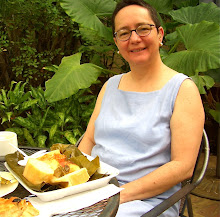
"Flora y Fauna" by Solignia Arellano. Oil on canvas. 14" X 11".
The primitive or "naive" genre of painting can be found around the world in virtually every culture. It is a special kind of artistic expression that speaks to the most fundamental emotions of the human species. The palette of this genre is often bright, deep and rich. The subject matter is timeless and easy to relate to, and the style is by definition straightforward and direct. Whatever the appeal, it has a universal attraction.
In Nicaragua, an unusual thread of primitive or naive painting developed in the island archipelago of Solentiname in the south end of Lake Nicaragua. The initial development of the artistic community of Solentiname came through the efforts of Padre Ernesto Cardenal who settled in the islands in the 1960's, and started a spiritual community. Over the course of ten years, he also encouraged the islanders to experiment with artistic endeavors. As a natural consequence, the artistic, spiritual and economic strands in Solentiname became intertwined, resulting in what has become known as "liberation theology". For more information see /www.nicaartgallery.com/artist/solentiname.asp.
The artist who created the beautiful NicaPOD today is Solignia Arellano, of the famous Arellano family workshop.









